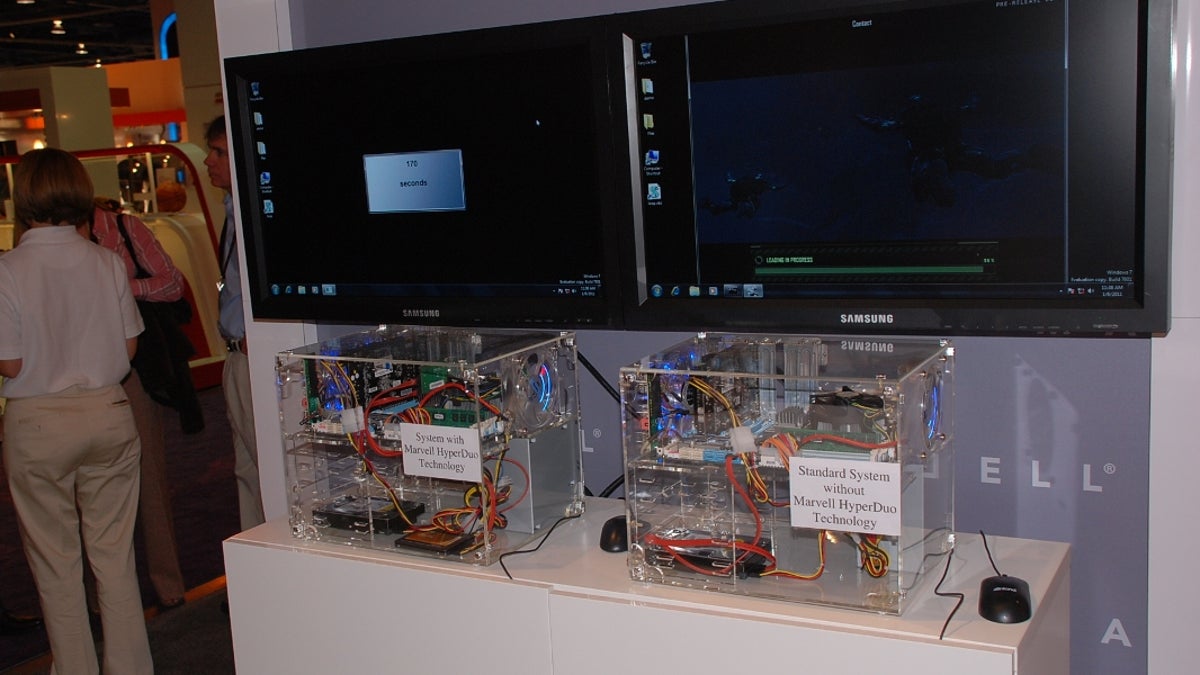Hands-on with the Marvell HyperDuo hybrid storage controller
Marvell's demos show that its HyperDuo hybrid storage controller is a great way to get the best out of your computer's storage.

LAS VEGAS--Marvell announced its new storage controller this week that combines a regular hard-disk drive (HDD) and a solid-state drive (SSD) to create a hybrid storage solution designed to offer SSD-like performance while retaining the capacity benefits of traditional hard drives.
Intrigued by the idea, I visited the company's demonstration today and found it indeed intriguing and at the same time practical.
At the demo, Marvel used a controller card, powered by its HyperDuo chip, that has two SATA 6Gbps ports. This card is similar to any PCIe SATA controller cards you find on the market. The difference is, the card supports Marvell's hybrid feature and automatically sets up an SSD and an HDD in Capacity Mode, which combines the two drives into a single volume in a RAID 0-like setup. When used with one or two regular hard drives, however, the card would work just like any other SATA 6Gbps card.
The best thing about this card is that it shares the same standard software driver that Microsoft uses for standard SATA connections. This means if you want to use the hybrid solution for the main drive of a computer (on which the operating system is installed), you won't need to seek a third-party software driver during the installation of the OS.
If users are not happy with the Capacity Mode, they can access the card's BIOS interface (by pressing Ctrl+M during the computer's start-up) to change it to Safe Mode. In Safe Mode, the total capacity of the hybrid solution is that of the larger drive, which is mostly likely the hard drive. This mode allows for keeping a copy of the smaller drive (the SSD) on the bigger drive (the hard drive) at all time. Apart from keeping the data safer, the Safe Mode also allows you to combine a new drive with another that already has information stored on it without having to lose data.
This mode has a much slower writing speed than the Capacity Mode, though, and that's because the information needs to be written to both drives at the same time. For this reason, plus the fact that SSDs tend to last longer than HDDs, Marvell implements the Capacity Mode by default. Setting up the two drives in this mode will erase any and all data on them, exactly the same as what would happen for a RAID 0 setup.
Once the two drives are set up, the card itself will detect frequently used data (hot files) and move them to the SSD part. However, there's also a software application that allows users to proactively move any portion of the data to the SSD, as long as it's smaller than the total capacity of the SSD. For example, you can choose to move an entire Office suite if you want Word, Excel, and so on to load really fast. And by "moving," all you have to do is add that suite to the list of prioritized applications; there's no actual data copying/moving involved from the user's perspective.
In essence, this solution allows users to use the SSD most of the time while keeping the hard drive as just a storage space for idle files and documents, which don't need to load very fast. In other words, most of the time, you use the computer as though it only had an SSD drive, hence the much-improved performance. The demo showed that the read and write speeds of the hybrid solution, in Capacity Mode, are basically those of the SSD drive. The larger the SSD is, the less frequently you'll need to access the hard drive.
As Marvell makes only the chip for the controller, it has had many hardware vendors agree to adopt the new controller. Early examples of the results are the controller card from Promise and motherboards with embedded HyperDuo controllers by Asus (model PHP67 Deluxe) or by Gigabyte (model GA-P67A-UD7). So, very soon you will be able to find them on the market.
Marvell is very tight-lipped on the price, but it says that the price of the controller should be within the same range as other SATA controller cards on the market, and the implementation of the controller won't hike up the price of motherboard, as the HyperDuo chip is relatively cheap to make.

